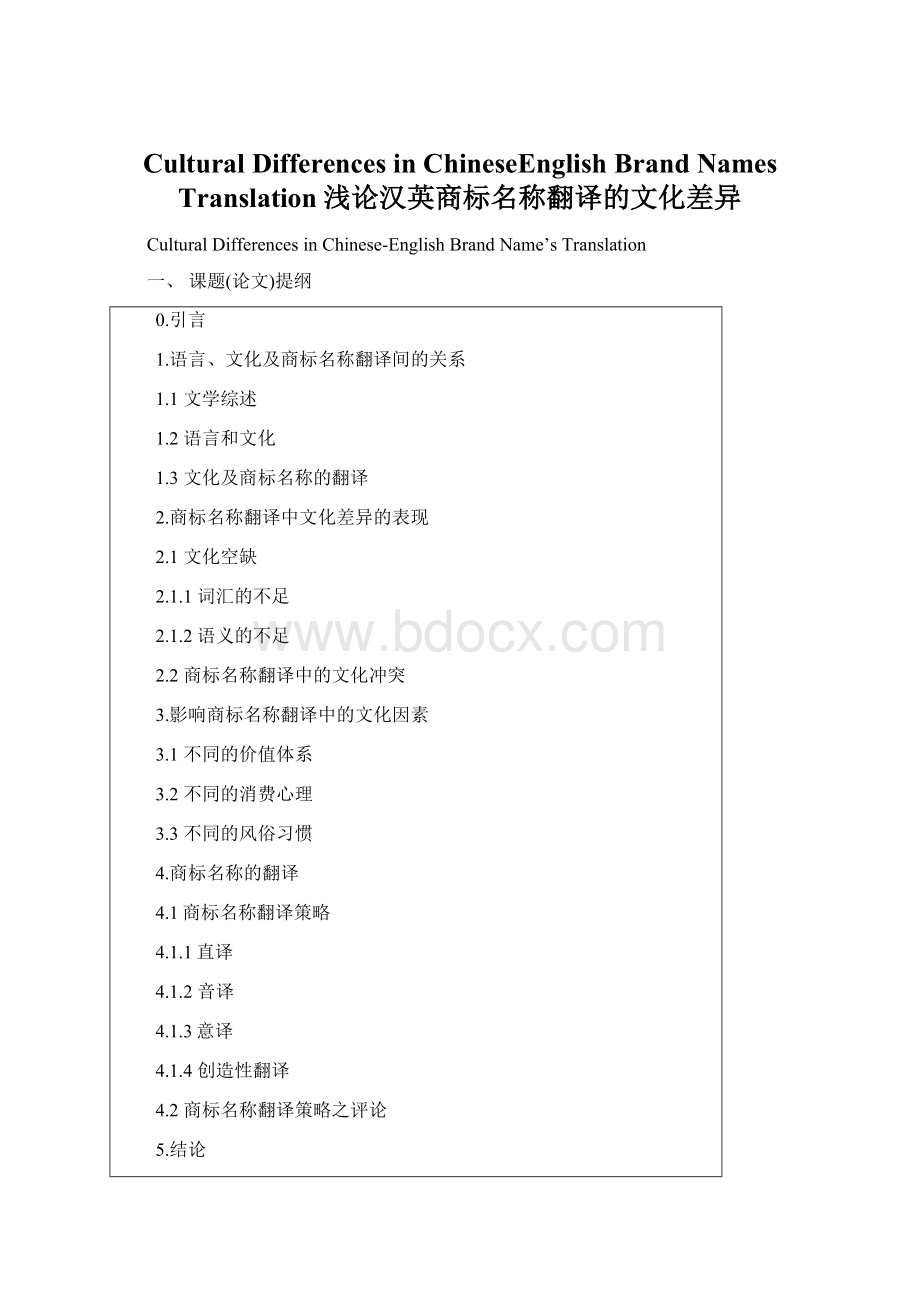Cultural Differences in ChineseEnglish Brand Names Translation浅论汉英商标名称翻译的文化差异.docx
《Cultural Differences in ChineseEnglish Brand Names Translation浅论汉英商标名称翻译的文化差异.docx》由会员分享,可在线阅读,更多相关《Cultural Differences in ChineseEnglish Brand Names Translation浅论汉英商标名称翻译的文化差异.docx(13页珍藏版)》请在冰豆网上搜索。

CulturalDifferencesinChineseEnglishBrandNamesTranslation浅论汉英商标名称翻译的文化差异
CulturalDifferencesinChinese-EnglishBrandName’sTranslation
一、课题(论文)提纲
0.引言
1.语言、文化及商标名称翻译间的关系
1.1文学综述
1.2语言和文化
1.3文化及商标名称的翻译
2.商标名称翻译中文化差异的表现
2.1文化空缺
2.1.1词汇的不足
2.1.2语义的不足
2.2商标名称翻译中的文化冲突
3.影响商标名称翻译中的文化因素
3.1不同的价值体系
3.2不同的消费心理
3.3不同的风俗习惯
4.商标名称的翻译
4.1商标名称翻译策略
4.1.1直译
4.1.2音译
4.1.3意译
4.1.4创造性翻译
4.2商标名称翻译策略之评论
5.结论
二、内容摘要
英语和汉语是目前世界上的两种主要语言,两种不同的语言也反映出两种不同的文化。
众所周知语言不仅是文化的一部分,还是文化的载体。
语言离不开文化,它只有在相应的文化中才有意义;同时文化也离不开语言,文化的发展也受语言的限制。
然而,中西方文化存在着很大的差异,译者通常会遇到文化差异所带来的障碍。
本文在分析商标词翻译中的中西方文化差异的基础上,主要分析两个不同方面:
文化空缺和文化冲突,同时也分析了文化对商标翻译产生的巨大影响,并提出了在翻译过程中如何更好地解除文化背景的障碍,有效地采取相应的翻译策略来迎合消费者的消费取向的建议。
三、参考文献
[1]Bloch,B.andTrager,G..OutlineofLinguisticAnalysis.Baltimore:
WaverleyPress.1942:
5.
[2]CharksHockett.ACourseinModernLinguistics.NewYork:
Macmillan.1956.
[3]Larry,A.SamovarandRichardE.Porter.CommunicationbetweenCultures.ThomsonLearningAsiaandForeignLanguageTeachingandResearchPress.2000.
[4]Leech,G.Semantics:
TheStudyofMeaning.GreatBritain:
theChaucerPress.1981.
[5]Nida,EugeanA.Language,CultureandTranslation.Shanghai:
ShanghaiForeignLanguageEducationPress.2002:
146.
[6]Samovar,LarryA.,Porter,PichardE.&Stefani,LisaA.CommunicationbetweenCultures.2000:
120.
[7]Taylor,EdwardB.PrimitiveCulture.London:
JohnMurray.1871:
36.
[8]包惠南.文化语境与语言翻译.北京:
中国对外翻译出版,2001:
274-287.
[9]林大津.跨文化交际研究.福州:
福建人民出版社,1996:
185-188.
[10]吕叔湘,丁声树等.现代汉语词典.北京:
商务印书出版社,1983:
373
[11]潘惠霞,李辉.汉译英过程中文化空缺现象探索,1(2000):
74-77.
[12]王秉钦.文化与翻译.天津:
南开大学出版社,3(1995):
110.
CulturalDifferencesinChinese-EnglishBrandName’sTranslation
Abstract:
EnglishandChinesearetwoofthemajorlanguagesintheworld,reflectingtwomaincultures.Itiswell-knownthatlanguageisapartofcultureandisthecarrierofcultureaswell.Languageandculturecannotbeseparatedfromeachother.Languagewouldbemeaninglesswithoutcultureandthedevelopmentofculturewouldberestrictedbylanguage.Atthesametime,translationisnotonlythebridgebetweendifferentlanguages,butalsotheinter-culturalcommunicationbetweendifferentcultures.However,translatorsoftenencountersomebarrierswhicharecausedbyculturaldifferencesintheprocessofcross-culturaltranslating.Thisthesisattemptstoexploretheculturaldifferencesandtheculturalimpactonbrandname’stranslationbetweenChineseandtheWesterncountriesthroughanalyzingthecharacteristicsofbrandname’stranslation.Atthesametime,theauthorgivesmoreattentiontothemainfactorsofculturaldifferences:
culturalvacancyandculturalclash.Furthermore,theauthoranalyzesthegreatinfluenceofculturalfactorsintheprocessofbrandname’stranslation.Whentranslating,translatorsshouldadoptsomeproperandusefulstrategiestoavoidthebarrierscausedbydifferentculturalbackgrounds.
Keywords:
language;culturaldifferences;culturalvacancy;culturalclash;brandname’stranslation
Introduction
Astheincreaseofinternationalcommunication,theexportedproductshavebecomeoneoftheimportantwindowstoshowthenationalculturetotheothercountriesinrecent.However,brandname’stranslationinvolveslanguageandculture,itasaveryimportantculturalcommunicationway,thebrandname’stranslationiscloselyrelatedtoculturalfactors.However,duringtheprocessoftranslation,translatorsalwaysencountersomedifficultiescausedbyculturaldifferences.Forinstance,thetranslatorscannotfindtheequivalentsinthetargetculture,orthetranslatorsoftenencountersomebarriersthattheconnotativemeaningsofquitealotofwordsinsourcelanguageareinconflictwiththeconnotativemeaningsoftheirequivalentwordsintargetlanguage.Then,theaimofthisthesisistoprobethedifferencesbetweenthetwoculturesaccordingtoquitealotofexamplesofbrandname’stranslation.
Culturalvacancyandculturalclashoftenleadtoalotofdifficultiesintheprocessofbrandname’stranslation.Andiftranslatorscannotdealwiththedifficultiescausedbyculturaldifferences,theconsumersinthetargetmarketoftenmisunderstandtheconnotativemeaningsofthebrandnames.Onthecontrary,effectivebrandname’stranslationcanhelppeoplefromtheentireworldtointercommunicatefreely.Atthesametime,brandname’stranslationcanmakeourculturericherandmorevivid,sogoodbrandname’stranslationplaysanimportantroleinintroducingculturalinformationbetweentwodifferentcultures.Inordertofindwhetherthebrandnamesatpresentmarketaretranslatedproperlyornot,thisthesismakesasystematicresearchonculturaldifferencesinbrandname’stranslation.Thestudycanimprovethefutureinterculturaltranslationintoahigherlevel.
Generallyspeaking,ChinesecultureisgreatlydifferentfromEnglishculture.DuetostrikingdifferencesbetweenChinesecultureandEnglishculture,barriersoftenoccurinbrandname’stranslation.Thisthesisistostudyculturaldifferencesinbrandname’stranslationbetweenChinaandtheWesterncountriesinordertomakepeoplerealizetheimportantroleofcultureandhelptranslatorstoobtainsuccessfulbrandname’stranslation.
Thedevelopmentsofthethesisareasfollows:
firstisanintroductiontothethesis.Afterintroduction,thefirstchapteranalyzesthecloserelationshipamongculture,languageandbrandname’stranslation.Languageisshapedbyculture,andlanguagecarriersculture,spreadscultureandhelpstodevelopculture.Andcultureislearnedbylanguage.Languageandculturearedependentoneachother.ThesecondchapteranalyzestheculturaldifferencesbetweenChinesecultureandtheWesternculturewhichincludeculturalvacancyandculturalclash.Thethirdchapterexplorestheimpactofculturaldifferencesonbrandname’stranslation,whichincludesdifferentvaluesystems,differentcustomsandhabits,anddifferentcustomerpsychology.Thefourthchapterisaproblem-solvingsection,whichexploresthepracticesofbrandname’stranslation.Lastisconclusion.Fromtheanalysisofpreviouschapters,itemphasizesagainthatbrandname’stranslationisakindofcross-culturalcommunication.Owingtothecloserelationbetweencultureandtranslation,itisimpossibletostudybrandname’stranslationwithoutculture.
Ⅰ.theRelationshipamongLanguage,CultureandBrandName’sTranslation
1.1LiteratureReview
Asinternationaltradeexpanded,theeffectsofculturearebecomingmoreandmoreimportant.ChinesecultureandEnglishculturebelongtotwodifferentsystems.Thisthesisgivesmoreattentiontoculturalvacancy.Thedefinitionof“vacancy”wasfirstproposedbyAmericanlinguistCharksHockettin1950s.Heused“randomholesinpatterns”todescribethelanguagephenomenonwhencontrastinggrammaticalpatternsoftwolanguages.
InChina,thereexisttwomaindefinitionsabout“culturalvacancy”:
WangBingqin(1995:
110)remarksthat“vacancy”referstotheculturalvacancyresultingfromunintelligiblethingsinSLthatwillbeeasilymisunderstoodatallbytargetculturereceptors.PanHuixiaandLiHui(2000:
74-77)givethisdefinitionthat“vacancy”referstotheuniquephenomenonoflanguageandculturewhichisspecifictoanationwhiledoesnotexistinanotherculture.
Althoughthesedefinitionsareexpressedindifferentwords,theyreflectonefactthatculturalvacancyreferstothelinguisticandculturalfactswhichexistinonenationalculturebutdefaultinanotherduetoculturaldifferences.
Theauthordividestheculturalvacancyintotwoaspects:
lexicalgapandsemanticgap.Sincelexicalgapiscloselyrelatedtolanguageandculture,itisbasicallymanifestedatthewordlevelandmorespecifically,tothedenotationandconnotationofawordbetweentwolanguages.Whenmentioninglexicalgaps,ProfessorLinDajinusesthetermof“Psychological-associatedmeaning”inInterculturalCommunicationStudies(1996:
185-188)todistinguishthefollowingfivetypes:
totalabsenceofpsychologicalassociation,thesamedenotationbutdifferentconnotations,thesamedenotationbutabsentconnotations,thesameconnotationbutdifferentdenotations,differentdenotationsanddifferentconnotations.Semanticgapsresultedfromthenon-equivalentsaremanifestedinthedenotationandtheconnotationofthewords.SomewordshavelessormoreconnotationsinEnglishthaninChinese,or,somewordsinbothlanguagesappeartorefertothesamethingonthesurface,butactuallyrefertoquitedifferentthings.Sincethe“culturalturn”inthe1990’s,translationconcernsnotonlythetransferringbetweenlanguages,butalsothetransferringbetweencultures.Themaindifficultiesintranslationcomefromthefactthatsomewordsinsourcelanguagecan’talwayshavetheirequivalentwordsintargetlanguage.So,duringtheprocessoftranslating,theproblemhowtodealwiththeculturaldifferencesisameaningfultaskforourstudy.
Intermsoftranslationprinciples,BaoHuinanstudiesC-Ebrandname’stranslationfromtheperspectivesoflanguageandculture.Headvancesthisprinciple:
translatorsmustrespectthenationalpsychologyandgrasptheassociativemeaning.Thechosenwordsshouldbesimple,brief,andcatchy(BaoHuinan,2001:
274-287).BaoHuinan(2001:
274-287)agreesthatcultureplaysanimportantroleinbrandname’stranslation,stressestheimportanceofanappropriateconversationofculturalmeaningandclearlyputsforwardtheopinionthatignoringculturaldifferencesmaycausepragmaticfailuresinbrandname’stranslation.
Accordingtothestudiesofotherscholars,theauthorattemptstodiscussculturaldifferencesinC-Ebrandname’stranslation.
1.2LanguageandCulture
Languageisasocialphe